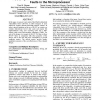17 search results - page 2 / 4 » Power Consumption of Fault Tolerant Codes: the Active Elemen... |
DAC
2004
ACM
14 years 26 days ago
2004
ACM
In order to improve the testabilities and power consumption, a new state assignment technique based on m-block partition is introduced in this paper. The length and number of feed...
DAC
2007
ACM
14 years 8 months ago
2007
ACM
Many STUMPS architectures found in current chip designs allow disabling of individual scan chains for debug and diagnosis. In a recent paper it has been shown that this feature can...
CODES
2009
IEEE
14 years 2 months ago
2009
IEEE
Time redundancy (rollback-recovery) and hardware redundancy are commonly used in real-time systems to achieve fault tolerance. From an energy consumption point of view, time redun...
MSS
2000
IEEE
13 years 11 months ago
2000
IEEE
Phoenix is a fault-tolerantreal-time network-attachedstorage device (NASD). Like other NASD architectures, Phoenix provides an object-based interface to data stored on network-att...
SIGMETRICS
2006
ACM
14 years 1 months ago
2006
ACM
In this paper, we present a new metric, Hard-Fault Architectural Vulnerability Factor (H-AVF), to allow designers to more effectively compare alternate hard-fault tolerance scheme...

